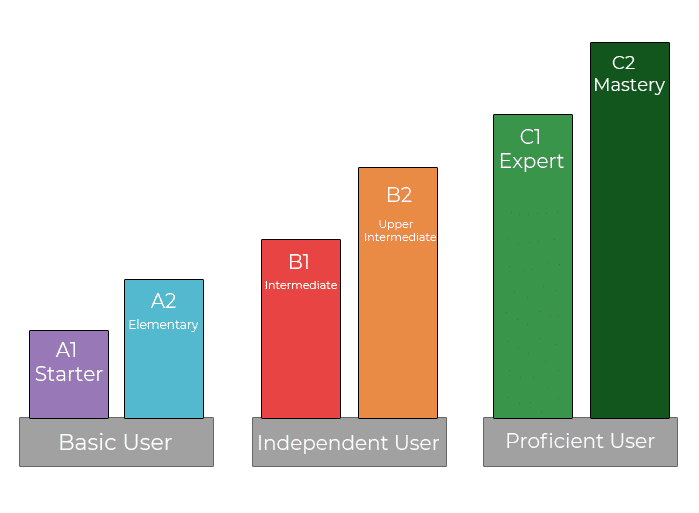If you are looking to take the IELTS test, you may also have heard about the CEFR and be wondering how the two tests work together. This article will help you understand how IELTS band scores can be converted to the CEFR fluency levels.
In this article, we’ll discuss:
- The CEFR and why it was created
- The IELTS and its different scores
- How to interpret the IELTS-CEFR conversion chart
- How you can prepare for the IELTS test online with GlobalExam
- How to prepare for the TOEFL with GlobalExam
Ready? Let’s dive right in!
What Is the CEFR and Why Was It Created to Begin with?
Unlike the ACTFL proficiency scale or any other language proficiency levels in English, the CEFR is different. Defining the level of fluency of a language, whether its English or not, can be tricky. It can be preferable to avoid broad and ambiguous terms such as “beginner”, “intermediate” and “advanced”. The CEFR or the Common European Framework of Reference for languages was created because there was an obvious need for more reliable indicators and especially for a standardized scale defining language fluency. If you’re looking to study abroad, the CEFR test is what universities in mainland Europe use to measure your language proficiency. But how does it work exactly? CEFR describes language ability on a six-point scale, from A1 for beginners, up to C2 for those who have mastered a language. Here is a graph that will hopefully make this clearer for you:

The CEFR is used for other tests in Europe as well. For instance the TOEFL scores are often converted to CEFR levels. If you’re interested in knowing more about how the CEFR levels convert to TOEFL, how the TOEFL score ranges by section, or how to send your TOEFL score to US Universities, you can find your answers on our blog.
What Are the IELTS Band Scores?
Now that we have quickly covered the CEFR scores, you must now be wondering how the IELTS band scores are scored. IELTS uses a 9 band scale for four sections: Listening, Writing, Reading and Speaking. Your IELTS Band score is based on the average score secured in four components. As you understand, the IELTS is not a level-based exam, as opposed to the CEFR. You will find below the detailed scores of the IELTS:
| Band score | Skill level | Description |
|---|---|---|
| Band 9 | Expert user | You have a full operational command of the language. Your use of English is appropriate, accurate and fluent, and you show complete understanding. |
| Band 8 | Very good user | You have a fully operational command of the language with only occasional unsystematic inaccuracies and inappropriate usage. You may misunderstand some things in unfamiliar situations. You handle complex detailed argumentation well. |
| Band 7 | Good user | You have an operational command of the language, though with occasional inaccuracies, inappropriate usage and misunderstandings in some situations. Generally you handle complex language well and understand detailed reasoning. |
| Band 6 | Competent user | Generally, you have an effective command of the language despite some inaccuracies, inappropriate usage and misunderstandings. You can use and understand fairly complex language, particularly in familiar situations. |
| Band 5 | Modest user | You have a partial command of the language, and cope with overall meaning in most situations, although you are likely to make many mistakes. You should be able to handle basic communication in your own field. |
| Band 4 | Limited user | Your basic competence is limited to familiar situations. You frequently show problems in understanding and expression. You are not able to use complex language. |
| Band 3 | Extremely limited user | You convey and understand only general meaning in very familiar situations. There are frequent breakdowns in communication. |
| Band 2 | Intermittent user | You have great difficulty understanding spoken and written English. |
| Band 1 | Non-user | You have no ability to use the language except a few isolated words. |
| Band 0 | Did not attempt the test | You did not answer the questions. |
After taking a look at the IELTS band scores, there are multiple ways to check your IELTS results, and we can help you with that.
*Please note that the scores are the same for the IELTS Indicator exam.
CEFR Levels to IELTS Conversion Chart
As you understand, the main difference between IELTS and CEFR is that IELTS is not a level-based exam and involves scoring on a 9 band scale. Not to mention that the formats of the two tests are very different. Hopefully, a conversion chart was created to define the relationship between CEFR and IELTS scores. Here is the comparison chart for you to convert your IELTS to CEFR:

If you want more easy conversions, you can check out our TOEFL Score to IELTS Conversion Chart.
Sample Interpretation of the Table
We understand that this chart can be a little bit confusing. You will find below detailed score comparisons to help you interpret it.
CEFR A1 & A2
CEFR A1 or A2 is equivalent to an IELTS score between 0 and 4. It means that you have a “basic user” level and that you have limited efficiency in using English in your daily life.
CEFR B1
CEFR B1 is equivalent to an IELTS score between 4 and 5. It means that you fall in the “independent user” category. It is considered sufficient for interactions with English speakers on familiar topics. You’ll need to work a bit harder to improve your scores if you want to get admitted to a university abroad.
CEFR B2
CEFR B2 is equivalent to an IELTS score between 5.5 and 6.5. You are considered an “Independent user” as well. It means that you can communicate easily and spontaneously in a clear and detailed manner. You are able to understand and be understood in most situations. With this score, you have a chance of getting admitted to certain top universities.
CEFR C1
CEFR C1 is equivalent to an IELTS score between 7 and 8. It means that you are a “proficient user” who can understand a wide range of demanding, longer texts, and recognize implicit meaning. From this score, you have high chances of getting admitted to certain top universities.
CEFR C2
CEFR C2 is equivalent to an IELTS score between 8,5 and 9. You are considered as a “proficient user” and it means that you have a fully operational command of English and that you are likely to get admitted to top universities.
Notes on overlapping
As you may have noticed, some IELTS scores may overlap on two scores of the CEFR chart. If you take a closer look at the chart above, you can notice that 6.5 is borderline B2 and C1. The first thing that you should know is that the interpretation of the score depends on the degree of certainty expected and varies across universities. This means that some applicants with a band of 6.5 may be at C1 fluency while others can be slightly below that. So if a university wants a high degree of certainty, it might map C1 to a band of 7 instead of 6.5. Before taking the IELTS test, it could therefore be interesting for you to double-check the language requirements of the university you’re looking to get into.
Check out our article on how to send your IELTS score to US Universities if you wish to do so after understanding how they work.
Frequently Asked Questions
Here are some Frequently Asked Questions (FAQ):
Q : Is this conversion chart official?
A: If you are wondering if the conversion chart is official, the answer is yes. CEFR is a standard for describing language ability used in Europe. The scale now helps IELTS teachers, examiners and students to compare language skills and scores from tests and qualifications. However, as mentioned before, the interpretation of the scores can vary from an institution to another.
Q: How can I convert my CEFR to IELTS?
A: You can convert your CEFR scores into IELTS scores using the conversion chart provided above in this article. You’ll notice that an IELTS band score of 7.0 is equivalent to a CEFR level of C1, and that an IELTS band score of 4.5 is equivalent to a CEFR level of B1.
Q: What CEFR level is considered fluent?
A: You are considered fluent when you reach a CEFR C2. To be considered C2 without any ambiguity, you need a minimum band score of 8.5 at your IELTS test. An 8 band can be interpreted as borderline, and some universities can consider that either C1 or C2.
Q: Is CEFR accepted in Canada?
A: The CEFR test is what European institutions use to measure your language proficiency. Canada asks for an IELTS score (you’ll then need to convert your IELTS score to CLB), not a CEFR score. You need a certain IELTS score for enrolling in Canadian Universities. You’ll therefore have to take the IELTS rather than the CEFR. If you’d like to work in Canada, the are also some IELTS score requirements for a Canadian PR (permanent residency), which is usually an overall 6.5 IELTS score. The good news is that we can help you achieve that specific score with a personalized training schedule. We’ve also made an article on the required IELTS scores for being a nurse in Canada.
Prepare for the IELTS Exam Online with GlobalExam
We hope that this article provided you with all the information you need about the IELTS and CEFR scores and how they can be compared. You may now be willing to take the IELTS and you are probably wondering how you could train for the test. At GlobalExam we can help you maximize your chances for success directly from home. Our online platform is designed to help candidates prepare for language proficiency tests such as the IELTS. You’ll be able to train for your test with many exercises and mock exams and benefit from detailed corrections and feedback. The statistics of your scores will be saved automatically so that you can review your answers and analyse your progression. Plus, you’ll be able to focus on your weaknesses thanks to more specific exercises based on your results as well as grammar and vocabulary revision sheets. The content is created and regularly updated by language tests experts in order to be the closest to the tests. If you wish to define an exam date with a specific level and goal, we can even help you train accordingly with a personalized schedule.



